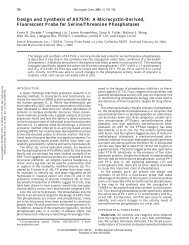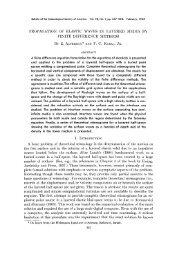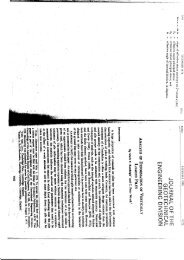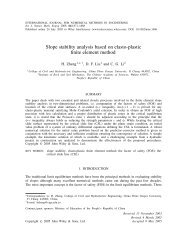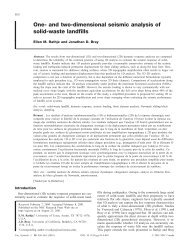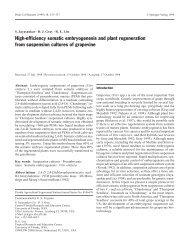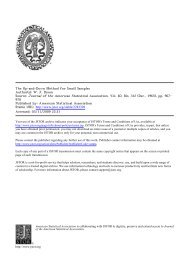Synthesis of large surface area LaFeO3 nanoparticles by SBA-16 ...
Synthesis of large surface area LaFeO3 nanoparticles by SBA-16 ...
Synthesis of large surface area LaFeO3 nanoparticles by SBA-16 ...
You also want an ePaper? Increase the reach of your titles
YUMPU automatically turns print PDFs into web optimized ePapers that Google loves.
J Nanopart Res<br />
a<br />
La3d<br />
50<br />
Intensity (a.u.)<br />
800°C<br />
3d 5/2<br />
3d 3/2<br />
DRS (%)<br />
40<br />
30<br />
20<br />
10<br />
900°C<br />
800°C<br />
700°C<br />
600°C<br />
b<br />
Intensity (a.u.)<br />
Intensity (a.u.)<br />
820 830 840 850 860<br />
Binding energy (eV)<br />
c<br />
700°C<br />
800°C<br />
700°C<br />
2p 3/2<br />
2p 1/2<br />
700 710 720 730<br />
Binding energy (eV)<br />
800°C<br />
700°C<br />
524 528 532 536<br />
Binding energy (eV)<br />
Fe2p<br />
wavelength range from 300 to 550 nm, with a SPS peak<br />
at about 390 nm, which can be attributed to the<br />
photoinduced electronic transitions from the valence<br />
band to conduction band (O 2p ? Fe 3d ) (Li et al. 2000).<br />
O L<br />
O L<br />
O H<br />
O H<br />
O1s<br />
Fig. 6 XPS spectra <strong>of</strong> La3d (a), Fe2p (b), and O1s (c) <strong>of</strong><br />
LaFeO 3 samples calcined at 700 and 800 °C<br />
0<br />
300 350 400 450 500 550 600 650 700<br />
Wavelength (nm)<br />
Fig. 7 UV–Vis DRS spectra <strong>of</strong> LaFeO 3 samples calcined at<br />
different temperature<br />
Moreover, the SPS response becomes much stronger<br />
with increasing calcination temperature, which is close<br />
related to the increase in the crystallinity <strong>of</strong> the LaFeO 3 .<br />
The high crystallinity makes electronic band perfect so<br />
as to enhance the built-in field strength, which can<br />
promote charge separation, meanwhile leading to the<br />
decrease <strong>of</strong> the defect amounts, which is also favorable<br />
for charge separation (Jing et al. 2006). According to the<br />
SPS method principles, it can be expected that the<br />
stronger is the SPS signal, the higher is the photoinduced<br />
charge separation rate. Thus, it can be supposed<br />
that the high crystallinity is favorable for the photoinduced<br />
charge separation and then improve the photocatalytic<br />
activity further.<br />
Photocatalytic activity evaluation<br />
The activity <strong>of</strong> the as-prepared LaFeO 3 was evaluated<br />
<strong>by</strong> photocatalytic degradation <strong>of</strong> Rhodamine B solution<br />
under visible light. Figure 9 shows the RhB<br />
degradation rate <strong>of</strong> photocatalytic reaction under<br />
visible irradiation and adsorption in the dark on the<br />
different LaFeO 3 samples and internationally commercial<br />
P-25 TiO 2 . As the calcination temperature is<br />
enhanced, it can be noticed that the photocatalytic<br />
activity <strong>of</strong> the as-prepared LaFeO 3 gradually increases,<br />
and the LaFeO 3 calcined at 900 °C exhibits excellent<br />
photocatalytic activity. Interestingly, all the LaFeO 3<br />
samples display higher visible activity than P25 TiO 2<br />
and those LaFeO 3 samples prepared via the citrate<br />
method (Li et al. 2007). Based on the above discussion,<br />
the high photocatalytic activity is mainly explained<br />
from the following two aspects. One is the <strong>large</strong> <strong>surface</strong><br />
123



